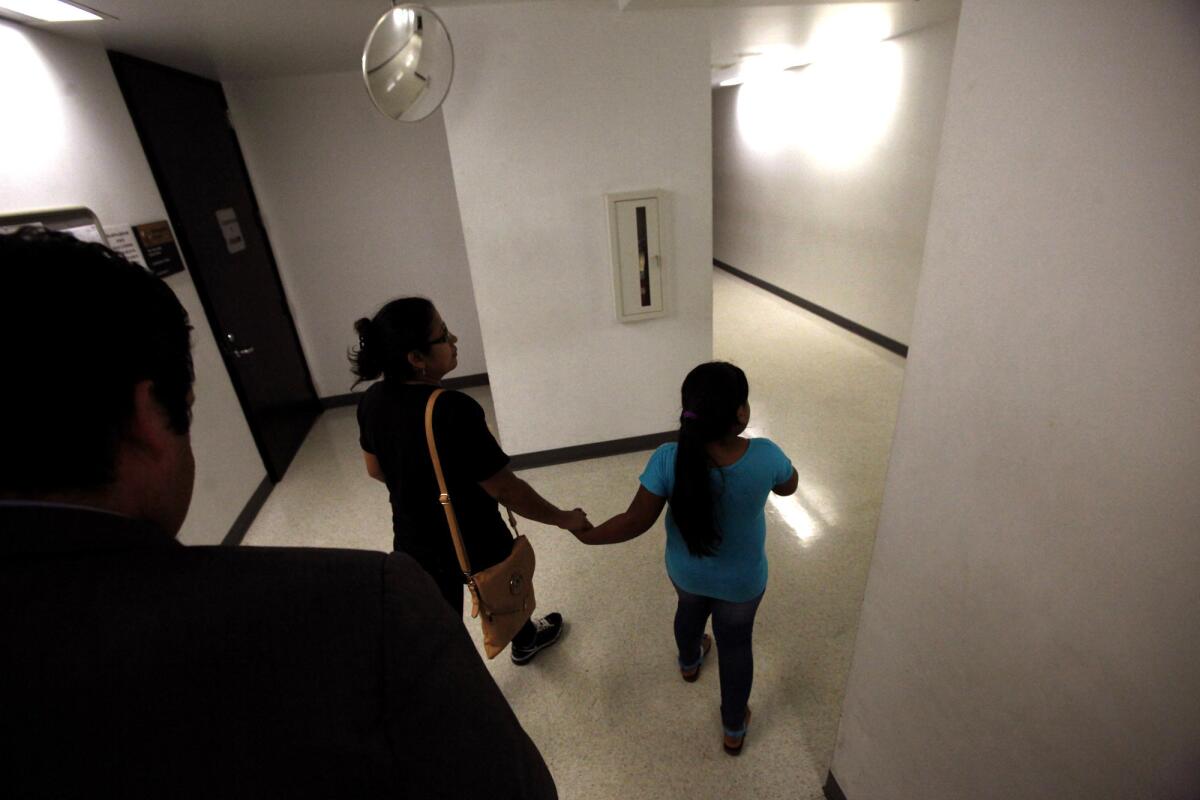Immigration: 445,000 awaiting a court date, which might not come for 4 years

Dayana Varela, 9, her mother, Silvia Padilla, and their attorney Alex Olguen leave an immigration court hearing in Los Angeles last year on an application for political asylum. There’s a growing backlog of cases in immigration courts nationwide.
- Share via
Reporting from Houston — Driven by last summer’s surge of illegal immigration from Central America, the already large backlog in federal immigration courts has reached an all-time high, with more than 445,000 pending cases, according to a new report.
As of April, the backlog hit 445,706 cases, a nearly 30% increase since Oct. 1, 2013, the start of the last fiscal year, according to the Transactional Records Access Clearinghouse at Syracuse University.
Immigration courts have been overwhelmed since the influx last fiscal year of more than 68,500 unaccompanied children and about as many family units crossing the southern border, most from Central America.
During that surge, unaccompanied children’s cases were given priority in the courts and expedited — referred to as “rocket dockets” — in Los Angeles and other cities.
Even so, they make up a small proportion of the backlog: 70,035 cases, about 16% of the total as of April. But the juvenile case backlog is still 68% larger than it was last June, when there was a backlog of 41,641 juvenile cases.
While most backlogged cases involved Mexican immigrants, their backlog has increased only about 4% since the start of last fiscal year, while the backlog has skyrocketed for Central Americans — up 63% for Guatemalans, 92% for Salvadorans and 143% for Hondurans.
The report, based on federal data, found that California, Texas, and New York led the nation with the largest immigration backlogs, followed by Florida and New Jersey.
The case backlog has been years in the making, and immigration courts are attempting to address the problem through staffing.
There are 233 judges in 58 courts nationwide, but 17 more are expected to start by month’s end, and 68 more are in the process of being hired, according to Louis Ruffino, a spokesman for the Executive Office for Immigration Review at the Justice Department, which handles immigration cases.
“Part of the solution to the backlog is a vigorous, ongoing hiring process to bring on more immigration judges,” Ruffino said.
As of this month, judges in Miami have also been hearing Texas immigration cases via videoconferencing, he said.
But some immigrant advocates said that’s not enough.
Denise Gilman, who directs an immigration clinic at the University of Texas law school in Austin, has a Honduran client who suffered a heart attack recently after waiting two years for his asylum case to be heard in San Antonio.
His case was bumped by others involving newly arrived and detained children and families, she said. Also, several judges in San Antonio retired, increasing the caseload for those who remained, Gilman said.
“There is no ability of the court to keep up,” she said. “We really are in a vicious cycle.”
Jonathan Ryan, executive director of the San Antonio-based legal advocacy group Raices, noted that when the federal government prioritized unaccompanied minors and detained families, “they were not addressing the cases that make up almost all of the backlog.”
“We see people coming into our office every day whose lives are being negatively impacted by this,” he said. He noted, for example, a Syrian family unable to work until their case is heard — which is not scheduled until 2019.
“Their whole family is in a state of paralysis or suspense because they can’t move forward in the backlog,” Ryan said. “The people being prioritized in the backlog are the most vulnerable children and mothers who are essentially getting railroaded. The prioritization is backwards.”
And some say the backlog is likely to get worse this year.
“We’re waiting for the tsunami to come” of judges retiring, said San-Francisco-based immigration Judge Dana Leigh Marks, who’s been on the bench for 28 years and is president of the National Assn. of Immigration Judges.
She said 100 immigration judges were expected to retire this year.
“If you look at how difficult the working conditions become when you are so overworked and not given the support that you need, it makes sense that what happens is people retire at their earliest opportunity,” Marks said. “That is really tragic for the country because these are skilled people.”
Many immigration judges, including Marks, now handle more than 3,000 cases. As a result, they have been forced to delay hearings for years, some until 2019.
“The pace of these cases continues to be relentless, particularly as the administration has chosen to prioritize recent arrivals,” she said. “It means that my pending caseload just gets pushed to the back, which is problematic in its own right because often there are compelling issues in those cases. People lose track of witnesses, a qualifying relative may pass away or become an adult, where it’s required the person be a child to confer a benefit.”
Though hiring more full-time judges is good, she said, “we believe there should be 100 immigration judges hired immediately and the size of the courts should be at least doubled, maybe tripled, based on a survey of how much time should be spent on each case.”
@mollyhf
More to Read
Sign up for Essential California
The most important California stories and recommendations in your inbox every morning.
You may occasionally receive promotional content from the Los Angeles Times.











